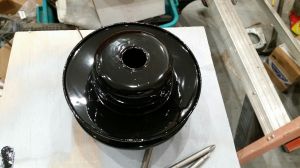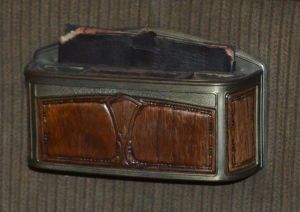- Home
- About Us
- Join/Renew
- Member Benefits
- Member Pages
- Log In
- Help
- Museum Store
David,
If you are doing the fabric pendant, add me in for a few. What would be nice is a porcelain type sign with the Pierce Logo, or says “Pierce authorized dealer””. I am sure my wife would love one for Mother’s Day!”
Greg,
I almost got thrown out of high school for doing a bit of shock therapy. Someone was stealing parts (tubes, resistors, etc.) from my room in electronics class (third years got their own rooms, more like closets). Not knowing who it was, I wired the high voltage of an RCA color TV to the metal door knob, and the ground to a metal door mat, and waited for the perp to strike. Didn’t take long, the next day I came into class to find several desks broken, and my electronics teacher waiting to escort me to the principal’s office. I found out it was the janitor that stole the stuff. I explained my side of the story, and got off with a warning to not fry anyone again. The janitor recovered from a few bumps and bruises, and never touched my room again.
By the way, I do have several 600mfd electrolytic capacitors laying around if you want to scare the wits out of someone. They are used on boat lift motors. Makes a beautiful blue spark. They stay charged for quite a while. Be happy to charge one and mail it to you…
Bob
Only David could come up with a joke like that. Keep ’em coming!
I got my feed grade molasses from the Webstaurantstore.com as I remember. The shipping was more than the 5 gallons of goop. Our “local” (I live 8 miles from the White House) Tractor Supply, which is out near Mr. Wozney’s place, doesn’t have it in stock. What does everyone use for getting rid of the grease and grime? For the Pierce parts, I use paint grade kerosene to minimize damage to the parts. Then it is off to the walnut shells in the vibrator. Looking for something faster if possible.
Bill,
I am an engineer, so forgive me. The answer is: it depends. The more tarnished, the longer it will take. Brass, chrome and copper take less time in walnut shells than steel. You just have to experiment, and determine how smooth and bright you want. I would start with overnight and play with it. In reality, 24 hours is a good call for most items.
Bob
William,
You might want to look at the vibratory tumblers from Eaastwood. The little one has an issue with the hold down assembly for the top (it vibrates loose over time, epoxy it back together), but it works great on rare parts. I use either walnut shells or glass beads, and let it work for a day or so. Put it somewhere away from the edge of the workbench… It cleans the special bolts for almost anything, including the chrome acorn nuts and other chrome bolts on the Pierce. Even brass looks shiny after a day or so as long as the parts are reasonably grease free to start.
After you smooth the metal a bit, you might want to use safety wire (either waxed with a non-silicone wax or with a thin film of wheel bearing grease) and dip it directly in the Plasti Dip. There will be a drip, but you can control where it goes. The wood will cause a flat spot and also cause you to have to cut the Plasti Dip away from the stick. It’s like the old fashioned candle making process.
I am working on the old trick of a solution of Molasses and water as a rust remover. Procedure and pictures of the louvered grill on my ’29 to follow in a week or so. Should be a real fly catcher!
Carl,
Others may have the detail you are looking for. I sent my clutch to Fort Wayne Clutch in Indiana here in the States. They rebuilt the clutch and sent it back. It is a work of art. They have been doing these since the cars were made. I realize you have a guy in England that is already involved, so you may want to have him contact Fort Wayne. My guess is they will provide the information you need.
Bob
I hope you don’t drink out of that cup. You know Beethoven died from his drinking cup- it was made of lead…
Is a ’29 Club Brougham the same? Mine is on the bench waiting for the engine to be assembled.
If the notes are instructions, perhaps you could share them with us.
Spoken like a true gearhead, David! Well said, as usual.
William, this is beautiful work. One suggestion I would make is to ensure the contacts are cleaned of any chemicals, sand, walnut shells, or whatever you used to clean and/or de-corrode the electrical contacts. As important as the look and feel of a regulator is, the most important aspect is its performance. You will likely have to spend some time tweaking it when you put it together. I would suggest cleaning the contacts with a point file (NOT sandpaper), or contact cleaner, then do what you can to preset the contacts before starting the engine and/or the charging process.
You guys who post these in process renovations keep us lurkers enthralled. Thanks, and please keep posting pics of your progress. David, that includes you! You do beautiful work, time to show it off once in a while!
Bob
Here is a picture of the fan pulley with the Eastwood 2K paint. I am an ASE Master body guy with 40 years doing paint as a sideline. This was done with a cheap detail gun in a 60 degree garage and way too much air pressure. OK, I was in a hurry! You can see how I ran the stuff, and how thick it is. Having said that, you can also see how this can lay out beautifully if everything is done right.
I like Greg’s suggestion of the Glyptal. The best way to stop the flow of fluid is to stop it from entering the wall you are trying to protect. Glyptal also helps prevent sludge buildup.

Eastwood now sells a 2k engine enamel that I used on my ’29 block for the first time. It is amazing paint, and if it does as advertised, will give you as good a sheen as you can get. It is, however, a challenge for the novice. It is very thick even with the reducer. If you don’t have experience with this type of paint, take it to a shop. Not sure if they have clear or aluminum, but the gloss black is better than regular basecoat clearcoat for sheen, and is tough as nails.
David Coco picked up one of Karl’s tool rolls for me at Hershey. It is an excellent product. Karl must have three hernias from carrying all that stuff to Hershey every year, but we really appreciate him doing it, as well as his knowledge in this area. He usually has an interesting Pierce for sale as well.
Is that oak? I thought the “better”” cars used ash.
Great Find!”
I will post a picture when I get the engine back, hopefully on Wednesday. You are right about the scaler, I forgot about them, as I don’t have one in the tool inventory. This engine block is a replacement, as my original one was cracked through two cylinders (2 and 3) between the bore and the valves due likely to overheating. The head is fine, though it was repaired at some point around the water outlet.
More later. Thanks for the thoughts so far.
Were any of the chips in the oil pan? Any evidence of excessive heat or over-torquing?
With that kind of upholstery, I am shocked not to see some shag carpet. David, that interior would take quite a while to bring back to tasteful, eh? It does look like a UUR2 carb, at least. Gotta love the color choice on the head.
It does have a PAS medallion on the front end. Is this in the register somewhere?
Hopefully I can download the picture. This is a shot of the left side vanity from my ’29 Club Brougham. The interior is all original. It even has the mirror with cover. Pierce really did a nice job with the faux wood paint.

Before you adjust the spring, I would give the moving parts a spray of Aerokroil, CRC 5-56 or one of your favorite penetrants. Let it sit for a while, and see if it helps. Loosening the spring can cause air leaks. The better approach is to find the source of the resistance. I would not use silicone, it will cause issues, such as the inability of the carb and anything the silicone touches, to accept paint.
